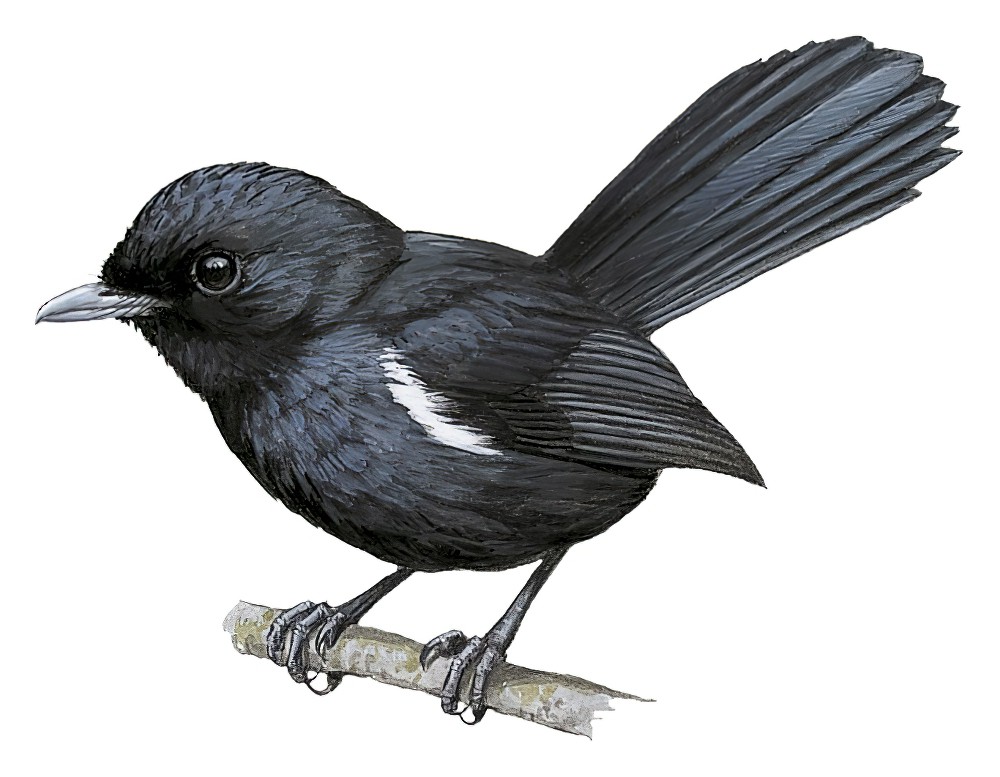Fan-tailed Monarch / Symposiachrus axillaris

Fan-tailed Monarch
SCI Name:
Protonym: Monarcha axillaris Ann.Mus.Civ.Stor.Nat.Genova 7(1875) p.921
Taxonomy: Passeriformes / Monarchidae / Symposiachrus
Taxonomy Code: blamon1
Type Locality: Profi, Arfak Mountains; altitude 3,400 feet.
Author: Salvadori
Publish Year: 1876
IUCN Status: Least Concern
DEFINITIONS
SYMPOSIACHRUS
(Monarchidae; Ϯ Spectacled Monarch M. trivirgatus) Gr. συν sun, συμ sum together; ποσις posis husband; αχρως akhrōs pallid; "Mélanornithés ... Symposiachrus, Bp., a pour type la trivirgata, qu'il était impossible de laisser parmi les Monarcha, car c'est un véritable Myagrien. Par ces disjonctions il ne reste plus de Monarcha légitimes que le type du genre, Mon. carinata, Vig., et la Drimophila cinerascens, Temm." (Bonaparte 1854).
Var. Symposiarchus (Gr. συμποσιον sumposion drinking party, guest; αρχος arkhos leader).
Synon. Heteranax, Lorimonarcha, Monarchalba, Penemonarcha, Piezormona.
axillaris
L. axillaris of the armpit < axilla armpit.
● ex “Axillary Falcon” of Latham 1801 (Elanus).
SUBSPECIES
Fan-tailed Monarch (axillaris)
SCI Name: Symposiachrus axillaris axillaris
axillaris
L. axillaris of the armpit < axilla armpit.
● ex “Axillary Falcon” of Latham 1801 (Elanus).
Fan-tailed Monarch (fallax)
SCI Name: Symposiachrus axillaris fallax
fallax
L. fallax, fallacis false, deceptive, deceiving < fallere to deceive. Epithet most frequently given to forms originally falsely identified, allocated to the wrong genus, or of uncertain relationships.
● "Differs from falki Hart. (Russian Turkestan) in being somewhat paler and duller on the upper side, the white eyebrow-stripe narrower; the crown of the head uniform fawn-colour; the chest paler and with narrow black bars on the flanks" (Sushkin 1927); "Hellmayr [1929] regards fallax as indistinguishable from pallida" (J. Peters 1934, II, 65, footnote) (subsp. Alectoris chukar).
● "I have two examples of a second species of this genus from Jamaica, which is, I suppose, undescribed. Before I had an opportunity of examining Mr. Osburn's specimens I was inclined to believe the latter were Mr. Gosse's E. cotta; but I now find that they are quite different, - Elainea fallax, as I propose to call it" (P. Sclater 1861) (Elaenia).
● "Io credei che questa specie potesse essere riferita al genere Euthyrhynchus, Schleg., che invece ho verificato essere identico al mio genere Timeliopsis" (Salvadori 1878) (Glycichaera).
● "The short crest of the males of this form furnishes the only certain character to distinguish it from huarandosae of the Chinchipe Valley. In ascertaining this measurement, the length of the occipital feathers should be taken rather than the distance from the exposed base of the culmen to the tip of the crest, since stretching or contraction of the skin of the head in preparation of the specimen will give a totally false conclusion" (J. Zimmer 1945) (subsp. Islerothraupis cristata).
● "This species bears a very close resemblance to Z. melodia, of which it is the western representative" (Baird 1854) (subsp. Melospiza melodia).
● "It was often killed by mistake, as it had a habit of perching motionless in low, thick brush or on the branch of a tall tree, where its plain colors made it difficult to identify. For this reason I think its name appropriate" (McGregor 1904) (subsp. Pachycephala philippinensis).
● "On the whole this bird has the appearance of a miniature Dicrurus, and may have to be placed in a new genus" (Ramsay 1885); "Ramsay had written on the label "Rhipidura (?) fallax (Ramsay) should be put in a new genus". This indicates the difficulty this species presents in classification using external characters" (Longmore 1991) (subsp. Symposiachrus axillaris).
UPPERCASE: current genus
Uppercase first letter: generic synonym
● and ● See: generic homonyms
lowercase: species and subspecies
●: early names, variants, mispellings
‡: extinct
†: type species
Gr.: ancient Greek
L.: Latin
<: derived from
syn: synonym of
/: separates historical and modern geographic names
ex: based on
TL: type locality
OD: original diagnosis (genus) or original description (species)












